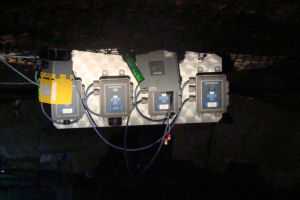Mining Topic: Fire Detection
What is the health and safety problem?
Fires continue to pose an ever-present hazard for U.S. underground coal and metal/nonmetal mines, particularly in conveyor belt entries and other underground locations where significant combustible materials may be stored or used. Fires that go undetected can spread rapidly, increasing in intensity and presenting a severe life threat to underground personnel due to the high levels of smoke and toxic gases produced.
What is the extent of the problem?
While the annual number of mine fires continues to slowly decrease, mine fires remain a significant problem. For instance, for the years 2010 and 2011, there were a total of 91 coal mine fires and 89 metal/nonmetal fires. The main causes of mine fires include flame cutting and welding operations, friction, electrical shorts, mobile equipment malfunctions, and spontaneous combustion. Preventing fires is essential to the health and safety of mine workers.
How is the NIOSH Mining program addressing this problem?
The Office of Mine Safety and Health Research (OMSHR) is working to improve the ability to detect and respond to developing fires using a multi-faceted approach that involves atmospheric monitoring of targeted mine locations. This approach seeks to (1) improve the gas and smoke sensors used in an atmospheric monitoring system (AMS) for fire detection and hazard analysis; (2) upgrade mine ventilation algorithms, such as MFIRE 3.0, to include dynamic fire growth, flame spread, and real-time contaminant transport; and (3) incorporate these improved mine ventilation algorithms into targeted mine locations to provide for a dynamic, real-time, and interactive system during actual fire emergencies.
What are the significant findings?
OMSHR research has led to the specification that CO and smoke sensor alarm levels and spacings be used in conveyor belt haulageways. Further OMSHR research has defined the response characteristics of those sensors currently approved for use in underground mines. In addition, OMSHR has developed models for how fires spread along conveyor belts and incorporated these models into the mine ventilation software MFIRE 3.0. All of these findings indicate that such approaches have great potential for improving our ability to detect and respond to developing mine fires quickly and with minimal harm.
What are the next steps?
The OMSHR Fire Prevention Team will continue its work to identify and test improved gas and smoke sensors for use in atmospheric monitoring systems. The capability of improved mine ventilation models, such as those created with MFIRE 3.0, to predict a fire’s effect on mine air velocities and the transport of contaminants will be validated and verified via extensive underground tests using an AMS operating continuously for the purposes of fire detection in OMSHR’s Safety Research Coal Mine in Pittsburgh, PA. The data obtained from these studies will be used to develop the appropriate interfaces between the AMS and the ventilation algorithms to provide for a real-time, interactive fire detection and warning system.
See Also
- Analyses of Mobile Equipment Fires for All U.S. Surface and Underground Coal and Metal/Nonmetal Mining Categories, 1990-1999
- Analysis of Mine Fires for All U.S. Metal/Nonmetal Mining Categories, 1990-2001
- Analysis of Mine Fires for All U.S. Underground and Surface Coal Mining Categories: 1990-1999
- CFD Modeling of Fire Spread Along Combustibles in a Mine Entry
- Evaluation of Smoke Detectors for Use in Underground Mines
- Fire Response Preparedness for Underground Mines
- Impact of Air Velocity on the Detection of Fires in Conveyor Belt Haulageways
- In-Mine Evaluation of Smart Mine Fire Sensor
- Innovative Strategies for Mine Fire Preparedness
- MFIRE - 3.0.50
- Mine Fire Detection in the Presence of Diesel Emissions
- Mine Fire Detection in the Presence of Diesel Emissions
- Mine Fire Diagnostics Applied to the Carbondale, PA Mine Fire Site
- NIOSH Mine Fire Research in the United States
- Overview of Mine Fire Detection
- Responders to Underground Mine Fires
- The Status of Mine Fire Research in the United States
- A Summary of U.S. Mine Fire Research
- Technology News 549 - MFIRE 3.0 - NIOSH Brings MFIRE into 21st Century
- Understanding Mine Fire Disasters by Determining the Characteristics of Deep-Seated Fires
- The Use of Light Scattering and Ion Chamber Responses for the Detection of Fires in Diesel Contaminated Atmospheres
- Page last reviewed: 4/7/2017
- Page last updated: 10/26/2012
- Content source: National Institute for Occupational Safety and Health, Mining Program


 ShareCompartir
ShareCompartir
